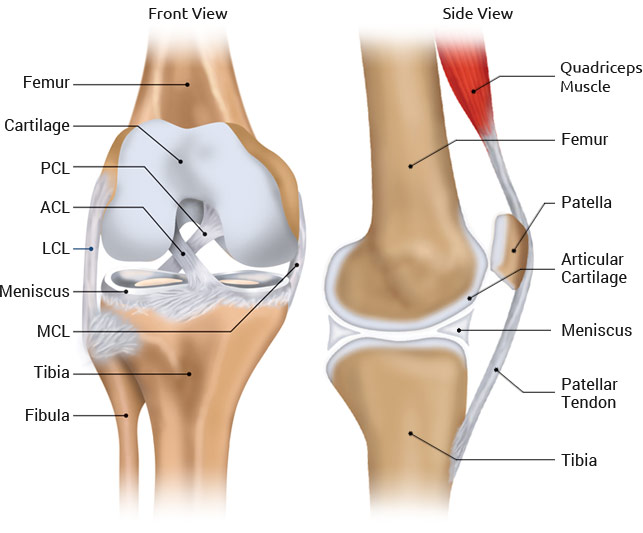 New functional capacity evaluation for ACL injuries definitely tests likeliness for re-injury and readiness to return to sport
New functional capacity evaluation for ACL injuries definitely tests likeliness for re-injury and readiness to return to sport
Arthritis
- Arthritis
- Patellofemoral Arthritis
- Unicompartmental Arthritis
Knee[nee] – Anatomy. The joint of the leg that allows for movement between the femur (thighbone) and tibia (shinbone) and has a sesamoid bone called the patella (kneecap) that offers protection and increases the power of the muscles surrounding the knee.
Your knees are the largest and the most commonly injured joints in your body. Unlike your shoulder that moves in all directions, your knees appear only to bend and straighten, but actually their movements are much more complex and involve rotation, translation, sliding and rolling.

There are four main ligaments connecting the bones at the knee joint and provide stability when you walk, run and jump. They are the:
The joint surface of the knee is covered with a thin, but robust, layer of cartilage over the ends of the femur, tibia and patella, and, along with the meniscus, allow the knee surfaces to articulate, move smoothly–almost frictionless and painlessly along each other. The cartilage and meniscus lack a blood supply and get their nutrition from the joint fluid. Without a blood supply, and because of their relatively less active cellular makeup, they cannot maintain or repair themselves. The cartilage and meniscus are extremely durable, but in time with “wear and tear” or following injury, they break down, fail and lead to meniscus tears, cartilage damage and eventually symptomatic (pain, stiffness, swelling) arthritis (failure of this protective joint surface).
Tendons also help provide knee joint stability and movement. They act like strong cables connecting your muscles to your bones. These muscle-tendon units cross joints from different directions to move or hold the joint in different directions or positions. Like other parts of your knee, they are susceptible to injury and tendonitis. The two knee tendons most commonly injured are the quadriceps and patellar tendons.
Because of the knee joint’s complexity, injuries can occur from a specific event or with ”wear and tear.” In either case, typical symptoms include:
If these symptoms persist for more than a week or worsen, despite conservative treatments like ice, rest and anti-inflammatory medications, you should make an appointment to have Dr. Chudik examine your knee. Delaying a diagnosis and the start of treatment often makes an injury worse and more difficult to treat.

Dr. Steven Chudik is renowned for his arthroscopic knee expertise and innovative procedures that reduce knee surgical trauma, speed recovery and yield excellent outcomes.
Dr. Steven Chudik is renowned for his arthroscopic knee expertise and innovative procedures that reduce knee surgical trauma, speed recovery and yield excellent outcomes.
Arthroscopy is a surgical procedure performed through small incisions that involves looking inside a joint with a tiny camera to help diagnose and repair the injury with equally small instruments inserted through other small incisions.
Arthroscopy has been performed since the 1970s. From the Greek words “arthro” (joint) and “skopein” (to look), the word literally means to look in the joint. Dr. Chudik is pioneer in arthroscopic shoulder and knee surgery. He developed several innovative arthroscopic orthopaedic procedures, instruments and implant solutions because he saw a need and invented a way to improve techniques that result in better outcomes for his patients.
Compared to an open surgical procedures, arthroscopy minimizes injury to the surrounding soft-tissues, and reduces postoperative pain, scar tissue and recovery time, allowing the quickest and most complete recovery of function, mobility, and performance.
Regardless if you have arthroscopic or open surgery, both have a risk for complications. Consequently, a decision to undergo surgery should never be taken lightly and trust in your surgeon’s expertise and dedication to helping you through the entire surgical experience is imperative.
The following are surgery procedures Dr. Chudik routinely performs, as well as the special arthroscopic surgical techniques he developed.
Since 2008, participation in hiking and backpacking in the United States has increased 62 percent to more than 47 million people. Mark Frantz is one of them having backpacked since the early 1990s among the beauty of the Rockies, Sierras and Teton mountains, as well as the Grand Canyon, Mount...
Read MoreRobert Nutt says he is retired, but his daily planner paints another picture. As president and managing director of Paceline Advisors, a strategic business and financial consulting firm Nutt created after 30 years in corporate finance and operations, he travels constantly and volunteers for three organizations and businesses. His hectic...
Read More